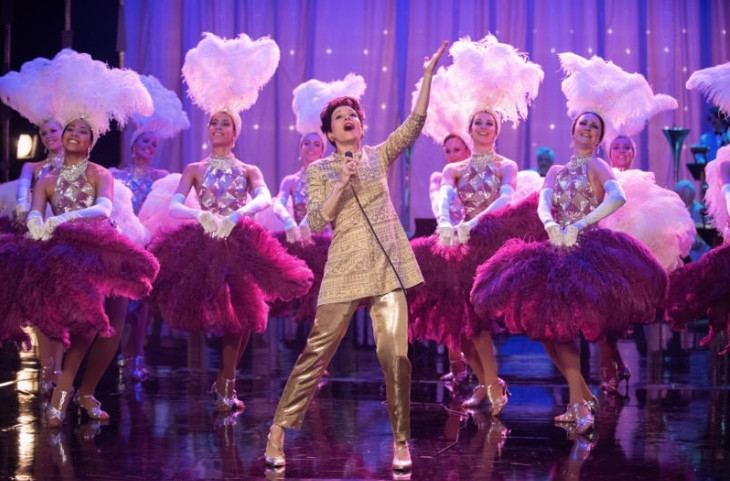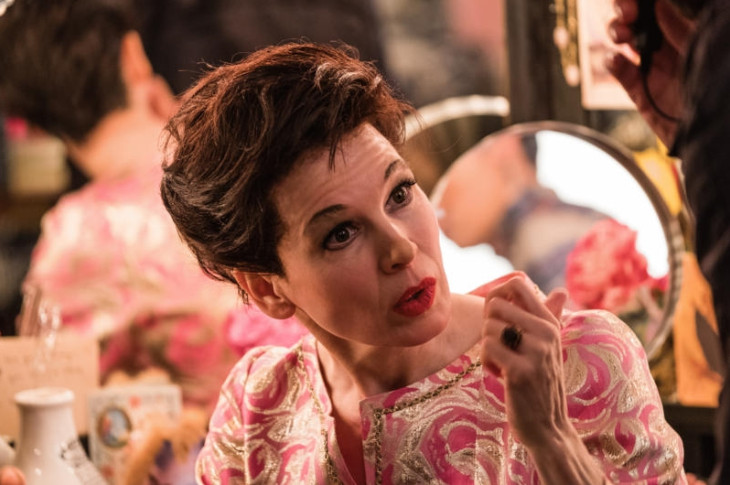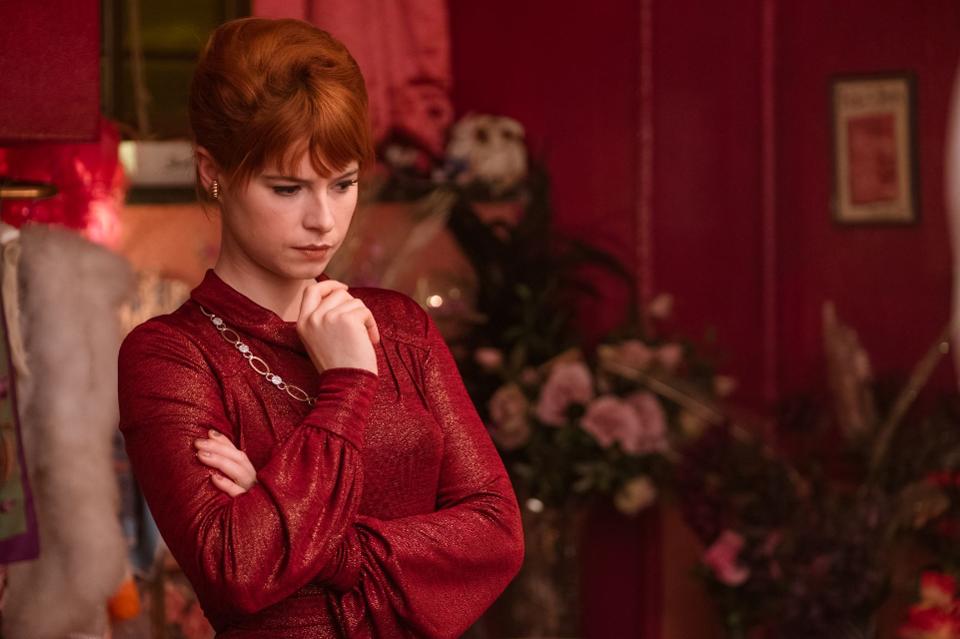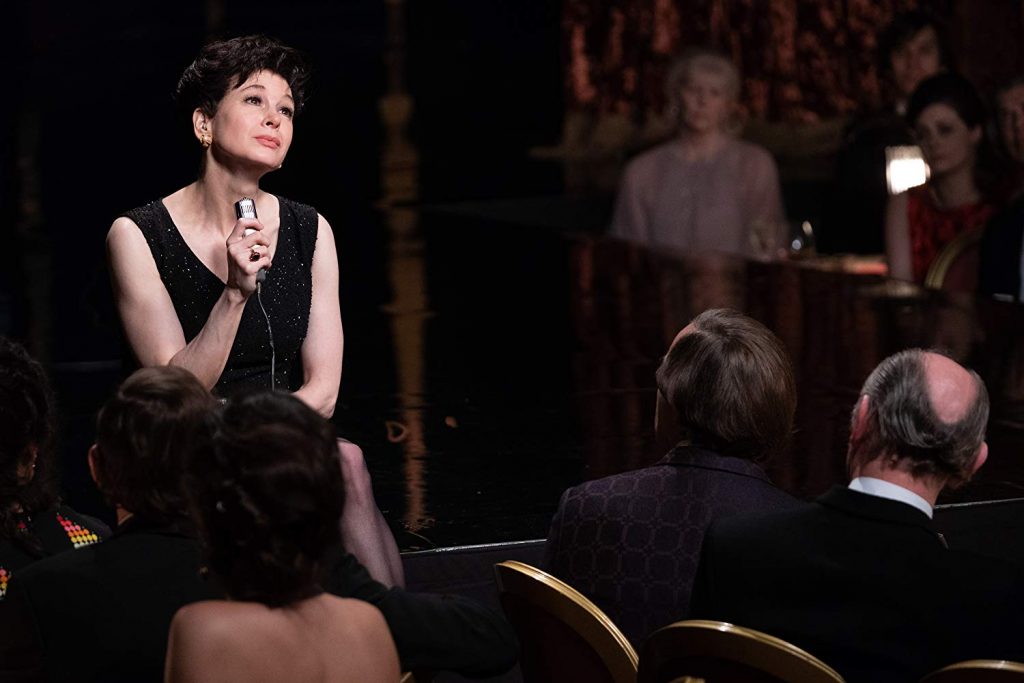Hand Renee Zellweger the Best Actress Oscar now! Zellweger is riveting. The emotional gravitas she brings to Garland is unparalleled. We feel Garland’s joy. We ache with her in pain. A tour de force performance. And the vocals? There are certain notes and passes in some of the songs that hit spot on Garland, although musical arrangements have been designed for Zellweger’s vocal range and there is no attempt to mimic a specific vocal performance. And while Zellweger doesn’t try to imitate Judy Garland, it’s Zellweger’s physicality – her smaller stature, posture with the little “stoop” that was noticeable in Garland in her stage performances, not to mention mic holds, cord tosses, and her very stage presence – that is Judy Garland. Zellweger captures the very essence of Garland and embodies that with every fiber of her being.

Set during Garland’s final stint at London’s The Talk of the Town mere months before her death, thanks to award-worthy costuming, cinematography, musical arrangements, and a tour de force Oscar-worthy performance by Renee Zellweger as Judy Garland, we are transported to a time and place we’ll now only find over the rainbow. It’s been 30 years since Judy Garland took us all over that rainbow into the Technicolor land of Oz. But time, pills, alcohol, husbands, agents and managers, have taken their toll on her. She is now broke, homeless, battling ex-husband Sid Luft to keep her children with her, and she has a reputation for unreliability. But give her a chance and get her on stage and the result is pure magic.
Written by Tom Edge and Peter Quilter based on Quilter’s stageplay “End of the Rainbow”, JUDY is directed by acclaimed theatre director Rupert Goold, a wise directorial choice given the theatricality of Garland’s life and the intimate focus of JUDY on this six week time period of The Talk of the Town and the very staging of those supper club performances. We see the lifelong conflict and contrast between Judy’s MGM candy-colored onscreen world of make-believe with the harsh realities of life. And while there are numerous issues with the script itself and the portrayal of certain individuals such as Louis B. Mayer, the production values sparkle and shine and do the heavy metaphoric emotional lifting, and no one production element is more outstanding than Ole Bratt Birkeland’s cinematography.

Definitely an interesting choice as the cinematographer to lens JUDY, Birkeland dazzles with his lighting and lensing, so much so that he should be one of the Oscar frontrunners. Thanks to hair and make-up and Birkeland’s lighting, there are numerous moments just in profile shots that you will find yourself doing a double take. It is Judy or is it Renee? Lighting is defining and helps not only to physically sculpt, but emotionally sculpt. The first real extreme close-up we have of Judy finds the camera zooming in closer, closer, closer, and still closer. The lighting is harsh, white white light, overlit on her face, but the effect is riveting – Judy looks almost ghostlike – afraid and a pale shadow of herself at the top of her game. That one moment defines the Judy we see in this film. Fearful of not having her children with her, fearful of not being herself, fearful of not living up to expectations, fearful that her voice and talent is gone. It sets the tone for what we now know would be the beginning of the end given her passing six months later after she ended with The Talk of the Town.
The stage lighting during The Talk of the Town shows is luxurious during performances and working in conjunction with the costume fabrics, is reflective and sparkling, not to mention metaphorically speaking to the mask of stardom. Camera dutching with on stage performances makes Judy look larger than life. . .until the “Somewhere Over the Rainbow” number when she crumples to the stage. The camera is eye level with her that entire performance, follows her to sitting on the stage and then slowly goes in closer as tears flow and her voice fails. She is a little girl lost and has come full circle since the first day she walked onto the MGM lot. Countering all of that is the lighting and lensing in the Los Angeles hotel, the cabs (very intimate), the London hotel. The use of cornflower and ice blues in the London hotel are beautiful onscreen and the camera has a fluidity to it when we visit Judy in the hotel, and then Judy and Mickey Deans (ironic that Judy Garland, who loved Mickey Rooney as a young girl, would go on to marry someone named Mickey – makes you wonder!), the latter having an almost puppy dog love feel to them. Striking is the lensing of scenes between Judy and her Talk of the Town assistant Rosalyn Wilder who is brilliantly played by Jessie Buckley. Watching the growth and chemistry between the two over the course of Judy’s run is poignant and telling.

When viewing the totality of the film, it must be noted that it’s not often anyone is eye level with Judy. Key individuals are always standing and appearing even more imposing than they already are. She is never in a power position. There are a few scenes where we get Judy on a “level playing field” sitting opposite someone, be it Michael Gambon’s Bernard Delfont or Rufus Sewell’s Sid Luft in the London bar talking about custody (she now has money coming in and is not forced to bow down to Luft) or ultimately with Jessie Buckley’s Rosalyn. And then the scenes with Richard Cordery as Louis B. Mayer and Darci Shaw as young Judy – wow! When the camera is on Mayer, it dutches upward from young Judy’s eye level. When the camera is on her, it dutches downward making Mayer look like he’s 10 feet tall. Very psychologically effective for the idea of control.
But let’s talk about the Louis B. Mayer scenes. Classic film fans and Mayer’s family (some whom I know personally) are going to be less than pleased with his portrayal in this film. And this is nothing against Cordery’s performance. This has to do with script and context. It was well known he was called “Mr. Mayer” by his stars and employees alike, especially by young actors like Garland, Roddy McDowall, Mickey Rooney, Elizabeth Taylor – not LB as is in the film dialogue. And then there is a particularly unsettling scene set in 1939 on the MGM lot inside the barn on Auntie Em and Uncle Henry’s farm with the yellow brick road to the side where Mayer puts his two fingers on her chest and starts to run them down to her breast alluding to sexual harassment. Obviously this was pulled from the 2009 biography by Gerald Clarke who allegedly found reference in an unpublished unauthorized unfinished Garland memoir. Is it even necessary to put this in this film? No; particularly when there is no form of follow-up to it in Judy’s later years.

Darci Shaw does an admirable job as young Judy but when casting a role for someone as well known and as well documented as Judy Garland, little details become key. Darci Shaw is on screen with jet black hair. Classic film fans and Garland afficionados know that Judy’s hair was not black and certainly not in “The Wizard of Oz.” The style is right for the Garland-Rooney days, but the color and Darci Shaw’s whole look is more like a young Elizabeth Taylor than a young Judy Garland. Note to casting directors: if anyone is thinking of making a film on Elizabeth Taylor in her youth and early days at MGM, hire Darci Shaw.
This jury is out on Finn Wittrock as Garland’s last husband, Mickey Deans. Something just doesn’t sit right with his performance and the lack of chemistry with Zellweger is noticeable. On the other hand, Rufus Sewell is amazing as Sid Luft.

Royce Pierreson is a nice casting as Garland’s Talk of the Town musical conductor/pianist Burt. Interesting, however, is that while the real Burt Rhodes was white, the casting of Pierreson works well here. Judy always felt like a misfit and that she didn’t belong (and after 5 marriages, being broke, not having her kids – who can blame her). In 1968, misfits abounded with race, gender, sexual preference, so it works extremely well to have her bonding with fellow misfits, like this version of Burt, and two absolute faves in the film, Garland fans Stan and Dan played by Andy Nyman and Daniel Cerqueira. Fictional characters, they embody the legions of Judy Garland fans with a love and understanding that warms the heart and mandates a few tissues. And again, notable is that in the scenes with Judy, Stan and Dan, the characters are eye level as is the camera. They are equals. Similarly when Judy leans on the piano into Burt or sits on the piano bench.
The song selections and the musical and vocal arrangements are spectacular and as mentioned above, being upbeat but for two of the numbers, allow for Zellweger to not strain or force herself to “sound like” Garland. Much easier to do a “cover” that’s fast and upbeat than a ballad or torch song that relies on each and every note. “The Trolley Song” number is dynamic and kudos to Zellweger who works well with the dancers and choreography versus being on stage solo.

Another Oscar-worthy element of JUDY is Jany Temime’s costume design. Fabulous is an understatement. Her fabrications for the clothes worn by Judy are perfection not only for the period but for the persona of Judy, be it onstage or off, from Garland’s patented pantsuits to metallics and sequins to scarves. Those scarves! A Judy Garland signature piece! Streetwear for the average folks who populate the film is period-perfect as well.
At the end of the day, JUDY is a 6-week slice of life that paints a relatively complete emotional portrait of the life of Judy Garland, a woman who was basically sad, alone, fearful, believing she was unloved; a woman who lost herself in the cycle of pills and alcohol. They may have taken her to Oz, but they never let her find her way home. Watching JUDY one can see that she gave the world her all so they would have the joy and happiness that she herself so desperately sought.
Directed by Rupert Goold
Written by Tom Edge and Peter Quilter based on the stageplay “End of the Rainbow”
Cast: Renee Zellweger, Jessie Buckley, Finn Wittrock, Rufus Sewell, Michael Gambon, Richard Cordery, Darci Shaw
by debbie elias, 09/19/2019











